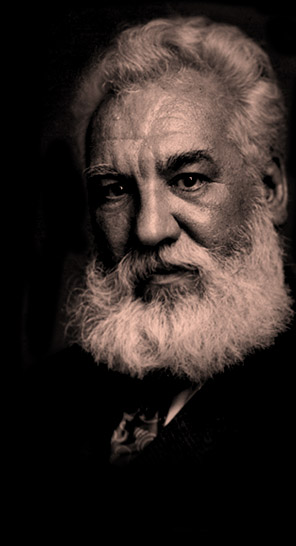- Biography
- Discoveries
- Read online
- Reading list
- Useful links
- Places to visit
- Did you know?
Alexander Bell and his brother Melville built a 'talking head' when they were young. They used bellows to force air through the windpipe, creating a very recognisable sound – 'Mama'.
Alexander Graham Bell (1847-1922)
Discoveries
Alexander Graham Bell is credited with the invention of the telephone.
Bell's progress with the telephone:
- 1870: Emigrated with his parents to Canada after both his brothers died of tuberculosis.
- 1875: Constructed the first telephone with his assistant Thomas Watson.
- 1876: The first clear sentence was transmitted – 'Mr Watson, come here; I want you.'
- 1877: Formed the Bell Telephone Company.
Tetrahedral kites
Bell invented the tetrahedral kite using regular four-sided polygons called 'tetrahedrons'. This pyramid-shaped framework is the strongest structure known.
The kite was a result of Bell's attempts to build a structure that was scalable and big enough to carry both a man and a motor. As such, it was an early experiment in flight.
Bell's intention was to use the tetrahedron shape as a building block for what we would call a 'flying machine', but he called an 'aerodrome'. Bell's word came to mean an 'airfield'. This aircraft would eventually be powered by a petrol engine and manned by a pilot.
In 1907, Bell launched his largest tetrahedral kite, the Cygnet II, over Bras d'Or lake in Cape Breton, Canada. The kite was towed behind a steam ship and carried a passenger – Lieutenant Thomas E Selfridge.
Bell's experiment was a milestone in the history of the development of flight.
Hydrofoils
Even as an early experimenter in aviation, Bell was concerned about safety.
He was never very happy when his young associates were risking life and limb 30 or 40 feet up in the air. Because water was safer for a crash-landing, he turned his attention to machines which could travel over water.
Bell began experimenting to design a machine which could take off from water. He looked at the hydrofoil, which has submerged blades to lift the moving boat out of the water. At that time, though, hydrofoils could not travel very fast.
With his assistant, Casey Baldwin, Bell made many models of hydrofoils – some of them very unstable. By 1912 Baldwin had designed the 'HD-1', which travelled at 30 miles per hour.
Not content with that, the two men continued their experiments, and in 1919 their HD-4 hydrofoil set a water speed record which was not beaten for 10 years.
Further developments
Bell did ground-breaking work in many other areas, including:
- Communications
- Sheep breeding
- Artificial respiration
- Water distillation.


